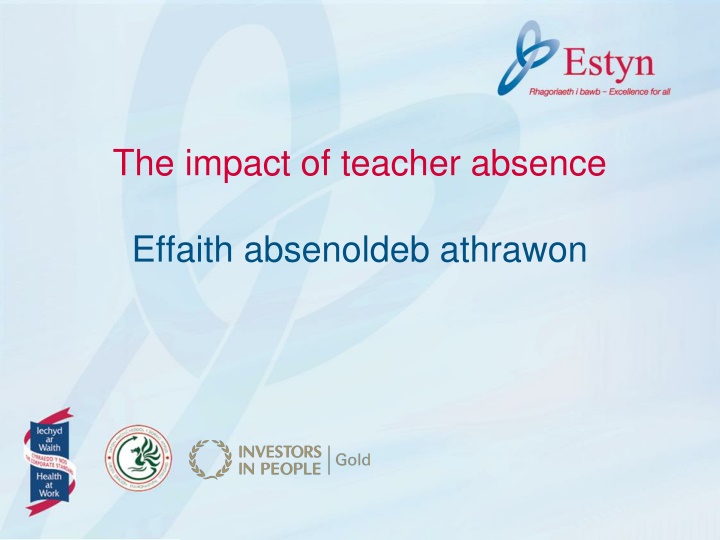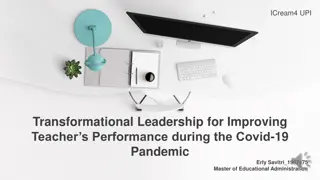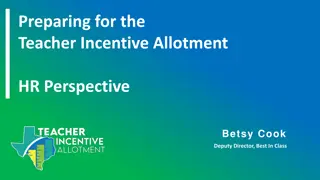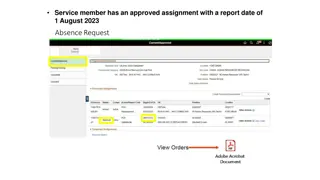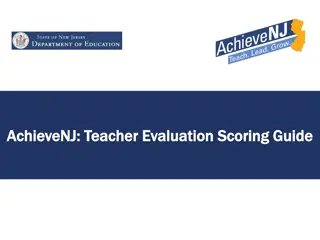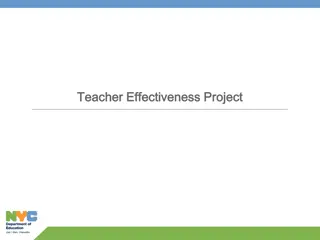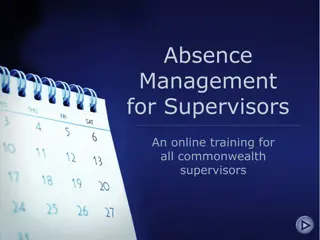The impact of teacher absence
The Welsh Audit Office estimates that around 10% of lessons are covered by staff other than the regular teacher, affecting student progress and behavior. In primary and secondary schools, learners struggle when their usual teachers are absent, leading to academic setbacks and classroom management issues. The involvement of supply staff not familiar with students' needs often results in ineffective teaching practices.
Download Presentation

Please find below an Image/Link to download the presentation.
The content on the website is provided AS IS for your information and personal use only. It may not be sold, licensed, or shared on other websites without obtaining consent from the author.If you encounter any issues during the download, it is possible that the publisher has removed the file from their server.
You are allowed to download the files provided on this website for personal or commercial use, subject to the condition that they are used lawfully. All files are the property of their respective owners.
The content on the website is provided AS IS for your information and personal use only. It may not be sold, licensed, or shared on other websites without obtaining consent from the author.
E N D
Presentation Transcript
The impact of teacher absence Effaith absenoldeb athrawon
Background Cefndir The Welsh Audit Office estimate that just under 10% of all lessons are now covered in total by staff who are not the usual class teacher. Since September 2009, teachers may cover only rarely and in circumstances which are not foreseeable. The introduction of rarely cover has led to an increased complexity in the provision of supply cover. Just over a third of supply teachers gained QTS five or less years ago and a similar proportion gained QTS more than 26 years ago. Erbyn hyn, mae Swyddfa Archwilio Cymru yn amcangyfrif bod ychydig yn llai na 10% o wersi yn cael eu haddysgu gan staff nad ydynt yn athrawon arferol y dosbarth. Er mis Medi 2009, gall athrawon ond cyflenwi mewn achosion prin ac mewn amgylchiadau anrhagweladwy. Mae cyflwyno cyflenwi prin wedi arwain at fwy o gymhlethdod wrth ddarparu athrawon llanw. Enillodd ychydig dros draean o athrawon llanw Statws Athro Cymwysedig (SAC) bum mlynedd neu lai yn l, ac enillodd cyfran debyg SAC dros 26 blynedd yn l.
Main findings Prif ganfyddiadau Teachers should cover the absence of colleagues only under unforeseeable circumstances. Dylai athrawon gyflenwi yn absenoldeb cydweithwyr mewn amgylchiadau anrhagweladwy yn unig. One outcome of this rarely cover agreement has been an increasing involvement of support and cover staff in the delivery of pupils education. Un o ganlyniadau r cytundeb cyflenwi prin hwn yw ymglymiad cynyddol staff cymorth a llanw wrth gyflwyno addysg disgyblion. Caiff ei amcangyfrif bod ychydig yn llai na 10% o wersi yn cael eu haddysgu gan staff nad ydynt yn athrawon arferol y dosbarth. It is estimated that just under 10% of all lessons are now covered by staff who are not the usual class teacher.
Main findings Prif ganfyddiadau In primary and secondary schools, learners make less progress in developing their skills, knowledge and understanding when the usual class teacher is absent, and learners behaviour is often worse, particularly in secondary schools. Mewn ysgolion cynradd ac uwchradd, mae dysgwyr yn gwneud llai o gynnydd o ran datblygu eu medrau, gwybodaeth a dealltwriaeth pan fydd athro arferol y dosbarth yn absennol, ac mae ymddygiad dysgwyr yn aml yn waeth, yn enwedig mewn ysgolion uwchradd. Mae disgyblion llai galluog yn llai tebygol o gael y cymorth sydd ei angen arnynt, ac mae disgyblion o allu canolig a r rhai sy n fwy galluog yn gwneud llai o gynnydd nag y dylent gan nad yw r gwaith sy n cael ei osod yn ddigon heriol. Less able pupils are less likely to receive the support they need, and middle ability and more able pupils make less progress than they should because the work set is not challenging enough. Mae dysgwyr mewn ysgolion uwchradd yn dueddol o gamymddwyn neu gymryd rhan mewn aflonyddwch ar lefel isel pan fydd athrawon llanw yn eu haddysgu. Learners in secondary schools tend to misbehave or engage in low-level disruption when taught by supply staff.
Main findings Prif ganfyddiadau In most schools visited, the teaching by supply staff not employed by the school is often ineffective, mainly because they do not know enough about the needs of the pupils they teach. Yn y rhan fwyaf o r ysgolion yr ymwelwyd nhw, yn aml mae r addysgu gan staff llanw nad ydynt yn cael eu cyflogi gan yr ysgol yn aneffeithiol, yn bennaf gan nad ydynt yn gwybod digon am anghenion y disgyblion y maent yn eu haddysgu. Even when cover supervisors are employed directly by the school, the pace of lessons is often too slow and expectations are too low. Hyd yn oed pan gaiff goruchwylwyr llanw eu cyflogi n uniongyrchol gan yr ysgol, mae rhediad gwersi yn aml yn rhy araf ac mae r disgwyliadau yn rhy isel.
Main findings Prif ganfyddiadau In most primary schools, the adverse effects of short-term teacher absence on pupils learning are reduced mainly through providing cover by staff who are employed at the school and are familiar with the learners and with school processes. Yn y rhan fwyaf o ysgolion cynradd, caiff effeithiau niweidiol absenoldeb dros dro athrawon ar ddysgu disgyblion eu lleihau n bennaf trwy ddarparu staff llanw sy n cael eu cyflogi gan yr ysgol ac sy n gyfarwydd r dysgwyr a phrosesau r ysgol. The greatest negative impact of teacher absence on pupils learning occurs in secondary schools. Supply staff who do not normally work at the school do not know the needs of the learners as well as their usual classroom teachers and the work set is often too undemanding and does not engage learners. Mae effaith negyddol fwyaf absenoldeb athrawon ar ddysgu disgyblion yn digwydd mewn ysgolion uwchradd. Nid yw staff llanw nad ydynt yn gweithio yn yr ysgol fel arfer yn gwybod am anghenion y dysgwyr cystal u hathrawon arferol ac, yn aml, nid yw r gwaith yn ddigon heriol nac yn ennyn diddordeb dysgwyr.
Main findings Prif ganfyddiadau In primary schools where there are two or more classes in each year group, joint planning helps to reduce the impact of teacher absence further. The greatest disruption in primary schools occurs as a result of not having a strategy to minimise the impact of unplanned, but potentially long-term, teacher absences. Most schools have suitable arrangements to provide cover for absent teachers by using internal cover staff (higher-level teaching assistants (HLTAs) or cover supervisors employed by the school) or by sourcing external supply teachers Mewn ysgolion cynradd lle mae dau neu ragor o ddosbarthiadau ym mhob gr p blwyddyn, mae cydgynllunio yn helpu i leihau effaith absenoldeb athrawon ymhellach. Mae r amhariad mwyaf mewn ysgolion cynradd yn digwydd o ganlyniad i beidio bod a strategaeth i leihau effaith absenoldebau athrawon heb eu cynllunio, ond a all fod yn hirdymor. Mae gan y rhan fwyaf o ysgolion drefniadau addas i gyflenwi ar gyfer athrawon absennol trwy ddefnyddio staff llanw mewnol (cynorthwywyr addysgu lefel uwch (CALUau) neu oruchwylwyr llanw sy n cael eu cyflogi gan yr ysgol) neu drwy ddod o hyd i athrawon llanw allanol.
Main findings Prif ganfyddiadau Many primary and secondary schools have appropriate administrative arrangements to support cover staff. Mae gan lawer o ysgolion cynradd ac uwchradd drefniadau gweinyddol priodol i gynorthwyo staff llanw. A few schools, particularly Welsh- medium schools and those located in rural or economically deprived areas, have difficulty finding suitable supply teachers. Mae ychydig o ysgolion, yn enwedig ysgolion cyfrwng Cymraeg neu rai sydd wedi u lleoli mewn ardaloedd gwledig neu economaidd ddifreintiedig, yn ei chael hi n anodd dod o hyd i athrawon llanw addas.
Main findings Prif ganfyddiadau Nid yw r rhan fwyaf o ysgolion yn rhoi digon o flaenoriaeth i reoli effaith absenoldebau athrawon nac i arfarnu ei effaith ar ansawdd profiadau dysgwyr. Most schools do not give enough priority to managing the effect of teacher absences or to evaluating its impact on the quality of learners experiences. Mae r rhan fwyaf o ysgolion ac asiantaethau addysgu yn rhoi adborth cyfyngedig i staff llanw ynghylch eu perfformiad, ac ychydig iawn o wybodaeth sy n cael ei chofnodi. Most schools and teaching agencies provide limited feedback to supply staff about their performance and little information is recorded.
Main findings Prif ganfyddiadau In the majority of schools, headteachers and other senior leaders now spend more time covering classes than previously. This is because they sometimes nominate themselves as cover, as they have difficulty sourcing supply staff. Generally, morale among supply staff working through recruitment agencies is low. They work in challenging circumstances and in many cases are not paid in line with the teachers main pay scale. Most cover supervisors and HLTAs employed permanently by schools have access to appropriate training as part of their school s in-service training programme. Erbyn hyn, mae penaethiaid ac uwch arweinwyr eraill yn y mwyafrif o ysgolion yn treulio mwy o amser yn addysgu dosbarthiadau eraill nag o r blaen. Y rheswm am hyn yw eu bod weithiau yn enwebu eu hunain, gan eu bod yn ei chael hi n anodd dod o hyd i staff llanw. Yn gyffredinol, mae mor l ymhlith staff llanw sy n gweithio trwy asiantaethau recriwtio yn isel. Maent yn gweithio mewn amgylchiadau heriol ac, mewn llawer o achosion, nid ydynt yn cael eu talu n unol r brif raddfa gyflog athrawon. Gall y rhan fwyaf o oruchwylwyr llanw a CALUau sy n cael eu cyflogi n barhaol gan ysgolion fanteisio ar hyfforddiant priodol fel rhan o raglen hyfforddiant mewn swydd eu hysgol.
Main findings Prif ganfyddiadau Most schools and teaching agencies provide limited feedback to supply staff about their performance and little information is recorded. Mae r rhan fwyaf o ysgolion ac asiantaethau addysgu yn rhoi adborth cyfyngedig i staff llanw ynghylch eu perfformiad, ac ychydig iawn o wybodaeth sy n cael ei chofnodi. Local authorities who provide lists of supply teachers do usually not request feedback on performance. Fel arfer, nid yw awdurdodau lleol sy n darparu rhestr o athrawon llanw yn gofyn am adborth ar eu perfformiad. Generally, morale among supply staff working through recruitment agencies is low. Yn gyffredinol, mae mor l ymhlith staff llanw sy n gweithio trwy asiantaethau recriwtio yn isel.
Main findings Prif ganfyddiadau Gall y rhan fwyaf o oruchwylwyr llanw a CALUau sy n cael eu cyflogi n barhaol gan ysgolion fanteisio ar hyfforddiant priodol fel rhan o raglen hyfforddiant mewn swydd eu hysgol. Fodd bynnag, ni all staff llanw eraill fanteisio ar ystod eang o gyfleoedd datblygiad proffesiynol. Most cover supervisors and HLTAs employed permanently by schools have access to appropriate training as part of their school s in-service training programme. But other supply staff do not have access to a wide range of professional development opportunities.
Recommendations Argymhellion Schools should: R1 manage teacher absence more efficiently; R2 improve the quality of teaching and learning in covered lessons by making sure that the work set is at an appropriate level and staff receive enough information on the individual needs of learners; R3 support supply and cover staff to improve their classroom behaviour management techniques; R4 evaluate the impact of teacher absence on learners, especially more able pupils and those in key stage 3, and monitor the quality of teaching and learning when teachers are absent; Dylai ysgolion: A1 reoli absenoldeb athrawon yn fwy effeithlon; A2 gwella ansawdd addysgu a dysgu mewn gwersi a gyflenwir trwy sicrhau y caiff y gwaith ei osod ar lefel briodol a bod staff yn cael digon o wybodaeth am anghenion unigol y dysgwyr; A3 cynorthwyo staff llanw i wella eu technegau rheoli ymddygiad yn yr ystafell ddosbarth; A4 arfarnu effaith absenoldeb athrawon ar ddysgwyr, yn enwedig disgyblion mwy galluog a r rhai yng nghyfnod allweddol 2, a monitro ansawdd addysgu a dysgu pan fydd athrawon yn absennol;
Recommendations Argymhellion R5 ensure that supply staff are included in performance management arrangements; A5 sicrhau y caiff staff llanw eu cynnwys mewn trefniadau rheoli perfformiad; R6 provide more professional development opportunities for supply staff; and A6 darparu rhagor o gyfleoedd datblygiad proffesiynol ar gyfer staff llanw; a R7 make sure that supply staff receive essential information on health and safety and safeguarding, including the contact details of the named child-protection officer at the school. A7 sicrhau bod staff llanw yn cael gwybodaeth hanfodol am iechyd a diogelwch a diogelu, gan gynnwys manylion cyswllt y swyddog amddiffyn plant penodedig yn yr ysgol.
Recommendations Argymhellion Local authorities and supply agencies should: Dylai awdurdodau lleol ac asiantaethau llanw: R8 provide schools with comparative data on teacher absence rates; and A8 ddarparu data cymharol i ysgolion ar gyfraddau absenoldeb athrawon; a R9 seek feedback on and record the quality of supply staff they register and use the information for quality control. A9 cheisio adborth ar ansawdd y staff llanw y maent yn eu defnyddio a i gofnodi, a defnyddio gwybodaeth i reoli ansawdd.
Recommendations Argymhellion Dylai Llywodraeth Cymru: A10 ddarparu mynediad gwell i athrawon llanw at y rhaglenni hyfforddiant cenedlaethol hynny sydd ar gael i athrawon sy n cael eu cyflogi n barhaol. The Welsh Government should: R10 provide better access for supply staff to those national training programmes that are available to permanently-employed teachers.
Suggested practice Arfer awgrymedig Suggested practice: Arfer awgrymedig: Birchgrove Comprehensive School Ysgol Gyfun Gellifedw Rhyl High School Ysgol Uwchradd y Rhyl
10 questions for providers 10 cwestiwn i ddarparwyr 1. Pa mor effeithiol yw eich trefniadau i gyflenwi ar gyfer athrawon absennol? Sut ydych chi n gwybod hynny? 2. A yw dysgwyr yn cael eu cynnwys mewn arfarnu effeithiolrwydd eich trefniadau i gyflenwi ar gyfer athrawon llanw? 3. Pa gyfran o wersi sy n cael eu haddysgu gan staff heblaw athro/athrawes arferol y dosbarth? 4. Faint o gynnydd y mae dysgwyr yn ei wneud mewn gwersi sy n cael eu haddysgu gan rywun heblaw athro/athrawes arferol y dosbarth? 5. Sut ydych chi n sicrhau bod y gwaith sy n cael ei adael pan fydd athrawon yn absennol yn briodol ac yn bodloni anghenion dysgwyr ar draws yr ystod gallu? 1. How effective are you arrangements to cover for absent teachers? How do you know? 2. Are learners involved in evaluating the effectiveness of your arrangements for covering for absent teachers? 3. What proportion of lessons are covered / taught by staff other than the usual class teacher? 4. How much progress do learners make in lessons covered by someone other than their usual class teacher? 5. How do you ensure that work left when the teacher is absent is appropriate and meets the needs of learners across the ability range?
10 questions for providers 10 cwestiwn i ddarparwyr 6. Sut ydych chi n sicrhau bod y gwaith sy n cael ei adael pan fydd athrawon yn absennol yn briodol ac yn bodloni anghenion dysgwyr ar draws yr ystod gallu 7. Ydych chi n cael ac yn dadansoddi unrhyw ddata cymharol ar absenoldeb athrawon? 8. Sut ydych chi n monitro effeithiolrwydd eich trefniadau pan fydd athrawon yn absennol? 9. A oes unrhyw bynciau lle r ydych yn ei chael hi n anodd cael arbenigwyr pwnc i gyflenwi ar gyfer athrawon absennol? Beth yw effaith hyn? 10. Pa mor gadarn yw eich polisi ar gyfer rheoli absenoldebau staff? A yw r polisi hwn yn cael ei gymhwyso n gyson ar draws yr ysgol? 6. How do you ensure that supply staff (employed internally and sourced externally) are aware of school policies and procedures and implement these? 7. Do you receive and analyse any comparative data about teacher absence? 8. How do you monitor the effectiveness of your arrangements to cover teacher absence? 9. Are there any subjects where you find it difficult to source subject specialists to cover for absent teachers? What is the impact of this? 10. How robust is your policy for managing staff absence? Is this policy applied consistently across the school?
Web-link to full report: English Dolen we i r adroddiad llawn Cymraeg: Cymraeg
Questions Cwestiynau...
